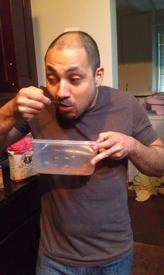Food scale: grams or measuring cups?

wordpainter09
Posts: 472 Member
Those of you with a food scale: do you use weight or cups/tablespoons to measure your food?
I measured a half cup of oat bran cereal on the scale. The serving size SAID 1/2 cup or 40 grams, but a half cup measured exactly out was 56 grams on the scale!!
I'm not sure what to go by...the measuring cup or the grams.
What do you all use?
I measured a half cup of oat bran cereal on the scale. The serving size SAID 1/2 cup or 40 grams, but a half cup measured exactly out was 56 grams on the scale!!
I'm not sure what to go by...the measuring cup or the grams.
What do you all use?
0
Replies
-
if its something you can weigh then i would weigh it... if its a simple cup (like milk or a liquid) i would just use a measuring cup. But anything solid i usually use a scale to measure.0
-
^^^^ Exactly like Babs! I would only use a cup for a standard liquid measurement. I use the scales for just about everything.0
-
Always weight over measuring cups here. For exactly what you discovered. 40 grams today will be 40 grams tomorrow and 40 grams the day after. But a half cup can be 45 grams today, 38 grams tomorrow, and 50 grams the day after.
The only thing I don't measure by weight is liquid. Though, actually, I even measure water by weight in one instance - I know that my perfect PB2 consistency is 26 grams of water rather than trying to measure two tablespoons of water, because it was too inconsistent in how my final mix would turn out. 0
0 -
I love my digital scale and measure everything in grams. It's the most precise way to measure (especially as some non-metric volume measurements vary from country to country. Gallons and pints are not the same everywhere, for example. And, I've heard that a "cup" is different, as well.)
Also, "sliced, one cup" just isn't precise. Sliced how fine? Packed how hard? And, who wants to put their food into a measuring cup or spoon, first? With grams, all you have to do is add it to the plate and watch the numbers.0 -
I went from scale to cups and beginning today, I'm trying to transition back to the scale. I'm leaving the scale on the counter for inspiration.
Thanks for the reminder, OP!
My only gripe now is going through my diary and changing the quantities for the today and tomorrow that I preplanned. But hey, I was able to actually eat MORE cereal than normal. Guess measuring sometimes works in your favour instead of against! :laugh:0 -
It doesn't surprise me that bran is looser in the factory than when you measured it home. But the weight won't change. Cups are the devil's measure. Use the weight, even if they put it second "1 cup (80 g)".0
-
Thanks guys!!
After measuring my cereals (oatmeal and oat bran, thank goodness they are healthy) I found out I've been getting an extra 200 cals per day from just these things!!!0 -
food = scale
liquids = cup0 -
Grams.0
-
Make sure if you are putting the food into some kind of container (bowl/Measuring cup) and then measuring it, that you reset the scale to zero with the empty container on first so it doesnt count the weight of the vessle.0
-
i use a scale for everything it is the only way to be accurate.....the designs alone allow for too much flexiblity in cups. Even though you wanna trust standard weights and measures ....it isn't like people are enforcing the exactness of a cup.....go with the scale for exact measures0
-
I suppose one way you could "check" is to see how many "cups" of oatmeal you logged over the last few days/weeks from that container - then compare it to the total number of servings and see if it comes out to be less. I actually have noticed that even though there were 13 (1/2 cup) servings in my tub of oatmeal, I only had accounted for 11.5 in my diary - meaning I was off by 225 calories. Not terrible over the course of a week, but still. I noticed that with peanut butter too - I just assumed that I was topping off the spoon or cup too much - but now I'm thinking its likely due to using a measuring cup instead of a scale!0
-
I weigh everything possible, even many liquids as the generic database entries include weight for a lot of them.0
-
This is exactly why it's better to weigh. There is a huge tendency to eat more then we think when using volume rather then weight, asyou just saw with your oatmeal.0
-
weight for solid things
measuring cups for liquids
basically if the food product says servings in grams, I weigh it
if the servings are listing in fluid ounces or mL - then it gets a measuring cup0 -
I love my digital scale and measure everything in grams. It's the most precise way to measure (especially as some non-metric volume measurements vary from country to country. Gallons and pints are not the same everywhere, for example. And, I've heard that a "cup" is different, as well.)
Also, "sliced, one cup" just isn't precise. Sliced how fine? Packed how hard? And, who wants to put their food into a measuring cup or spoon, first? With grams, all you have to do is add it to the plate and watch the numbers.
Like.0 -
I use digital scales for everything slid and everything inn liquid is in liters.0
-
Grams!!!
I did a test with my measuring cups and found I was measuring too many calories because my measuring cups were not accurate (at least with milk). I still use my cups because it is faster, but now I know not to reach surface tension when measuring with the cups.0 -
Weigh everything. Even liquids. The vast majority of liquids (anything with a water like consistency, like juice. milk, vinegar,) measure the same for weight and volume (i.e. one pint (16 oz) of water weighs one pound, or 448 grams.)0
-
Cups and grams are 2 different measurements!!
The only time 1 CUP (250ml) will equal 250grams is when the density of the food is 1 (water is one of the few things with a density of 1!)
CUP is Volume measurement and GRAMS is weight measurement (mass + gravity).
So keep measuring your liquids with cups and all your other ingredients on your food scale.0 -
I love my digital scale and measure everything in grams. It's the most precise way to measure (especially as some non-metric volume measurements vary from country to country. Gallons and pints are not the same everywhere, for example. And, I've heard that a "cup" is different, as well.)
Also, "sliced, one cup" just isn't precise. Sliced how fine? Packed how hard? And, who wants to put their food into a measuring cup or spoon, first? With grams, all you have to do is add it to the plate and watch the numbers.
This. I know where I stand with weights and I know some things are different between the UK and US measurements. It all gets very confusing with what I'm logging at times if I'm not sure which country an item in the database came from.0 -
You can use scales to estimate volume. Just be aware that it's only an estimate.
Some manufacturers actively promote the use of scales for estimating volume e.g. Saltar calls it 'aquatronic'. All they're doing is measuring the gram value and calling it ml. You can do the same with any scale.
Water has a density of 1 g/ml so you can measure 500 g of water and call it 500 ml. Many common liquids (e.g. milk, cream) have densities (hence error) within 5% of water. For ice cream, the error is within 10%. Yogurt is somewhere between the two. For honey and syrup, the error extends to 40% but you'd probably want weight measures for that anyway.0 -
I find weight is more accurate, but i will measure if my scale isn't handy.0
This discussion has been closed.
Categories
- All Categories
- 1.4M Health, Wellness and Goals
- 398.2K Introduce Yourself
- 44.7K Getting Started
- 261K Health and Weight Loss
- 176.4K Food and Nutrition
- 47.7K Recipes
- 233K Fitness and Exercise
- 462 Sleep, Mindfulness and Overall Wellness
- 6.5K Goal: Maintaining Weight
- 8.7K Goal: Gaining Weight and Body Building
- 153.5K Motivation and Support
- 8.4K Challenges
- 1.4K Debate Club
- 96.5K Chit-Chat
- 2.6K Fun and Games
- 4.8K MyFitnessPal Information
- 12 News and Announcements
- 21 MyFitnessPal Academy
- 1.6K Feature Suggestions and Ideas
- 3.2K MyFitnessPal Tech Support Questions

















